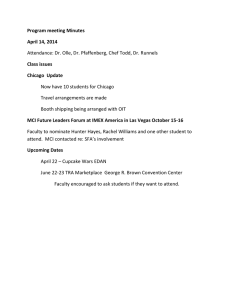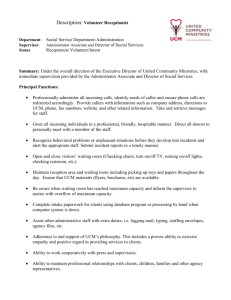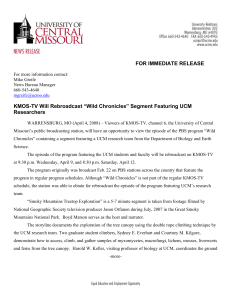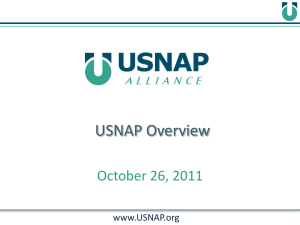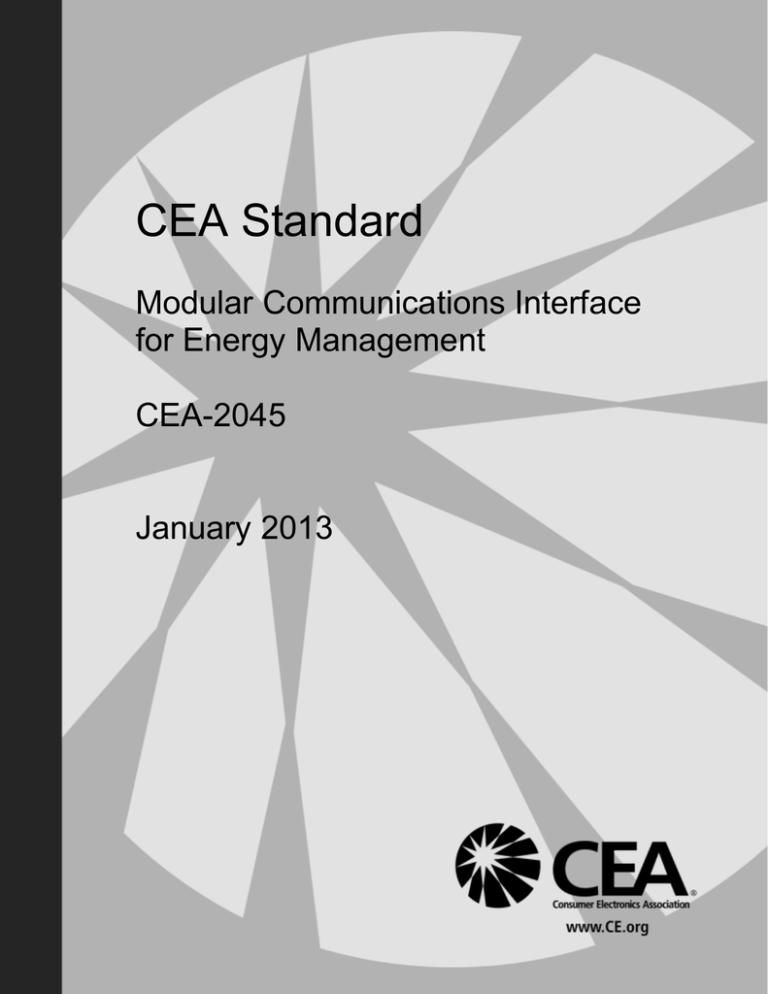
CEA Standard
Modular Communications Interface
for Energy Management
CEA-2045
January 2013
NOTICE
Consumer Electronics Association (CEA®) Standards, Bulletins and other technical publications
are designed to serve the public interest through eliminating misunderstandings between
manufacturers and purchasers, facilitating interchangeability and improvement of products, and
assisting the purchaser in selecting and obtaining with minimum delay the proper product for his
particular need. Existence of such Standards, Bulletins and other technical publications shall not in
any respect preclude any member or nonmember of CEA from manufacturing or selling products
not conforming to such Standards, Bulletins or other technical publications, nor shall the existence
of such Standards, Bulletins and other technical publications preclude their voluntary use by those
other than CEA members, whether the standard is to be used either domestically or internationally.
Standards, Bulletins and other technical publications are adopted by CEA in accordance with the
American National Standards Institute (ANSI) patent policy. By such action, CEA does not
assume any liability to any patent owner, nor does it assume any obligation whatever to parties
adopting the Standard, Bulletin or other technical publication.
Note: The user's attention is called to the possibility that compliance with this standard may
require use of an invention covered by patent rights.
By publication of this standard, no position is taken with respect to the validity of this claim or of
any patent rights in connection therewith. The patent holder has, however, filed a statement of
willingness to grant a license under these rights on reasonable and nondiscriminatory terms and
conditions to applicants desiring to obtain such a license. Details may be obtained from the
publisher.
This document does not purport to address all safety problems associated with its use or all
applicable regulatory requirements. It is the responsibility of the user of this document to establish
appropriate safety and health practices and to determine the applicability of regulatory limitations
before its use.
This document is copyrighted by the Consumer Electronics Association (CEA®) and may not be
reproduced, in whole or part, without written permission. Federal copyright law prohibits
unauthorized reproduction of this document by any means. Organizations may obtain permission
to reproduce a limited number of copies by entering into a license agreement. Requests to
reproduce text, data, charts, figures or other material should be made to CEA.
(Formulated under the cognizance of the CEA R7.8 Modular Communication Interface for
Energy Management Subcommittee.)
Published by
CONSUMER ELECTRONICS ASSOCIATION 2013
Technology & Standards Department
www.CE.org
All rights reserved
FOREWORD
This document was developed by the Consumer Electronics Association's R7.8 Modular Communications
Interface for Energy Management subcommittee.
I
(This page intentionally left blank.)
II
Contents
1
2
3
4
5
6
7
Introduction ...............................................................................................................................1
Scope .........................................................................................................................................2
2.1
References .................................................................................................................................... 3
2.1.1
Normative References .......................................................................................................... 3
2.1.2
Normative References List .................................................................................................... 3
2.1.3
Normative References Acquisition ....................................................................................... 3
2.1.4
Informative References......................................................................................................... 3
2.1.5
Informative References List .................................................................................................. 3
2.1.6
Informative References Acquisition ...................................................................................... 4
2.2
Compliance ................................................................................................................................... 4
2.3
Acronyms & Abbreviations ........................................................................................................... 5
Physical/Electrical Interface ........................................................................................................5
3.1
Removal and Exchange of a UCM ................................................................................................. 5
3.2
Block Diagram ............................................................................................................................... 6
Serial Protocol ............................................................................................................................6
4.1.1
Message Type Field ............................................................................................................... 7
4.1.2
Payload Length Field ............................................................................................................. 8
4.1.3
Checksum Field ..................................................................................................................... 8
4.1.4
Bit and Byte Order................................................................................................................. 8
4.1.5
Message Synchronization and Timing................................................................................... 8
4.1.6
SGD Handling of Conflicting Messages ............................................................................... 12
Simple Implementation ............................................................................................................ 12
Data-Link Messages .................................................................................................................. 12
6.1.1
Link NAK Error Codes .......................................................................................................... 15
6.1.2
Interface Power Limit Negotiation...................................................................................... 16
6.1.3
Bit Rate Negotiation ............................................................................................................ 17
6.1.4
Message Type Supported Query ......................................................................................... 18
6.1.5
Power-Up and State Reset .................................................................................................. 19
6.1.6
Security ............................................................................................................................... 19
6.2
Setting Slot Numbering ............................................................................................................... 19
Basic DR Application (Message Type = 0x08, 0x01)..................................................................... 19
7.1.1
Basic Message Fixed Length ................................................................................................ 25
7.1.2
Event Duration Field............................................................................................................ 25
7.1.3
Grouped Messages.............................................................................................................. 26
7.2
Usage and Details of Basic DR Application Messages ................................................................. 26
7.2.1
Request for Power Level (Opcode 0x06)............................................................................. 26
7.2.2
Relative Price Commands (Opcode 0x07 and 0x08) ........................................................... 27
III
7.2.3
Time Remaining in Present Price Period (Opcode 0x09) .................................................... 28
7.2.4
Operating State Monitoring (Opcodes 0x12 and 0x13) ...................................................... 29
8 Intermediate DR Application (Message Type = 0x08, 0x02) ........................................................ 30
8.1
Usage and Details of Intermediate DR Application Messages .................................................... 32
8.1.1
Info Request ........................................................................................................................ 32
8.1.2
Get/Set UTC Time................................................................................................................ 36
8.1.3
Get/Set Energy Price ........................................................................................................... 37
8.1.4
Get/Set Tier ......................................................................................................................... 38
8.1.5
Get/Set Temperature Offset ............................................................................................... 40
8.1.6
Get/Set Set Point................................................................................................................. 41
8.1.7
Autonomous Cycling ........................................................................................................... 42
8.1.8
Demand Reduction – Terminate Cycling............................................................................. 43
8.2
Demand Response Event Schedules ........................................................................................... 44
8.2.1
Send Scheduled Events Request ......................................................................................... 44
8.3
Energy Consumption ................................................................................................................... 44
8.3.1
Commodity Read................................................................................................................. 45
8.3.2
Get/Set CommodityType .................................................................................................... 46
9 Commissioning and Network Messages (Message Type = 0x08, 0x04) ........................................ 48
10 Pass-Through of Standard Protocols .......................................................................................... 49
10.1 Example Pass-Through Handling Instructions............................................................................. 50
10.1.1 USNAP 1.0 Protocol Pass-Through ...................................................................................... 50
10.1.2 SEP1.0 Pass-Through ........................................................................................................... 51
10.1.3 ClimateTalk Pass-Through ................................................................................................... 51
10.1.4 General Internet Protocol Pass-Through ............................................................................ 51
11 Example Communication Exchanges.......................................................................................... 52
12 General Security Principles........................................................................................................ 53
13 Load Management Event Randomization .................................................................................. 54
14 Compliance .............................................................................................................................. 55
15 Appendix A – Low Voltage DC Form Factor (normative) ............................................................. 55
15.1 Overview ..................................................................................................................................... 55
15.1.1 Limitations........................................................................................................................... 55
15.2 Physical Layer .............................................................................................................................. 55
15.2.1 Power for UCM.................................................................................................................... 55
15.2.2 Mechanical Interface .......................................................................................................... 55
15.3 Data-Link ..................................................................................................................................... 64
15.3.1 Messages ............................................................................................................................. 64
15.3.2 Operation ............................................................................................................................ 66
16 Appendix B – AC Form Factor (normative) ................................................................................. 71
16.1 Physical Form .............................................................................................................................. 71
16.1.1 AC SGD and AC UCM Connector ......................................................................................... 71
16.1.2 AC Enclosure requirements................................................................................................. 75
IV
16.2 AC Power ..................................................................................................................................... 79
16.3 Obtaining Message Sync ............................................................................................................. 80
17 Appendix C – Fletcher Checksum (normative) ............................................................................ 81
17.1 Calculating the Checksum ........................................................................................................... 81
17.2 Decoding the Checksum.............................................................................................................. 81
17.3 Example VB Code ........................................................................................................................ 81
18 Appendix D – Guideline for Computing Average Price (informative) ........................................... 82
Explanation for non-regulated utilities. .............................................................................................. 84
19 Appendix E – Product Safety Considerations (informative) ......................................................... 86
Figures
Figure 2-1 – Illustrations of the Modular Communications Concept on a controlled device (left) or Energy
Management Console (right) ........................................................................................................................ 2
Figure 3-1 – Modular Interface - Block Diagram ........................................................................................... 6
Figure 4-1 – Data-Link Timing ....................................................................................................................... 9
Figure 4-2 – Basic/Intermediate DR Application Layer Timing ................................................................... 11
Figure 7-1 – Non-Linear Event Duration Scaling ......................................................................................... 26
Figure 7-2 – Non-Linear Relative Price Scaling ........................................................................................... 28
Figure 10-1 – Pass-Through Message ......................................................................................................... 50
Figure 10-2– USNAP1.0 over Serial ............................................................................................................. 51
Figure 10-3 – SEP1.0 over Serial ................................................................................................................. 51
Figure 10-4 – ClimateTalk Over Serial ......................................................................................................... 51
Figure 10-5 – Internet Protocol Pass-Through (IPV6 Example) .................................................................. 52
Figure 13-1 – Example of Randomization of Events by Communications Modules ................................... 54
Figure 15-1 – DC Form Factor PCB Dimensions .......................................................................................... 56
Figure 15-2 – DC Form Factor Housing Dimensions – Top View................................................................. 58
Figure 15-3 – DC Form Factor Housing Dimensions – Side View ................................................................ 59
Figure 15-4 – DC Form Factor Housing Dimensions – End View................................................................. 60
Figure 15-5 – Pin Assignment ..................................................................................................................... 61
Figure 15-6 – SPI Mode 0 Bit Timing ........................................................................................................... 62
V
Figure 15-7 – SPI Data-Link Transaction Sequence: SGD-initiated message to the UCM ........................... 66
Figure 15-8 – SPI Data-Link Transaction Sequence: UCM-initiated message to the SGD ........................... 67
Figure 15-9 – SPI Data Transfer State Machine .......................................................................................... 69
Figure 16-1 – Panel Mount AC Connector Form Factor (Device Side Shown) and Pin-Out ........................ 72
Figure 16-2 – PCB-mount AC UCM connector (housing) ............................................................................ 72
Figure 16-3 – Cable AC UCM Connector (housing) ..................................................................................... 72
Figure 16-4 – Panel Mount AC SGD Connector Form Factor dimensions ................................................... 73
Figure 16-5 – PCB Mount Connector dimensions ....................................................................................... 74
Figure 16-6 – Cable Connector dimensions ................................................................................................ 74
Figure 16-7 – Contact dimensions for Cable Connector and PCB mount connector .................................. 75
Figure 16-8 – Reserved area and dimensions on SGD (receptacle) ............................................................ 76
Figure 16-9 – Right side and top view of maximum UCM dimensions ....................................................... 77
Figure 16-10 – Left side and bottom view of maximum UCM dimensions ................................................ 78
Figure 16-11 – Typical RS-485 Polarity and Byte Transfer .......................................................................... 79
Figure 16-12 – RS-485 Connections ............................................................................................................ 80
Tables
Table 4-1 – Protocol Data Unit Format ......................................................................................................... 6
Table 4-2 – Message Type Assignments ....................................................................................................... 7
Table 4-3 – Message Timing Requirements ................................................................................................ 10
Table 4-4 – Basic/Intermediate DR Application Layer Timing Parameters ................................................. 11
Table 5-1 – Mandatory Message Summary ................................................................................................ 12
Table 6-1 – Data-Link Command Set ........................................................................................................... 15
Table 6-2 – Link NAK Error Codes ............................................................................................................... 16
Table 6-3 – Interface Power Level Indicator Codes .................................................................................... 17
Table 6-4 – Bit Rate Indicator...................................................................................................................... 18
VI
Table 6-5 – Message Type Supported Query .............................................................................................. 18
Table 7-1 – Basic Application Data Format ................................................................................................. 20
Table 7-2 – Basic DR Application Command Set ......................................................................................... 25
Table 7-3 – Operating State Codes ............................................................................................................. 29
Table 8-1 – Intermediate DR Application Command Set (Command Byte Description) ............................ 31
Table 8-2 – Intermediate DR Application Command Set ............................................................................ 32
Table 8-3 – Response Code Values ............................................................................................................. 32
Table 9-1 – Commissioning and Network Messages .................................................................................. 49
Table 15-1 – Low Voltage Interface Signal Definitions ............................................................................... 62
Table 15-2 – SPI Physical Timing Requirements ......................................................................................... 68
VII
(This page intentionally left blank.)
viii
Modular Communications Interface for Energy Management
1 Introduction
Utilities worldwide are investing heavily in smart grid infrastructure that extends to homes and
businesses, with the goal of improving grid reliability and efficiency through increased consumer
awareness and participation. High hopes abound for grid connected homes and buildings to be better
prepared and more willing to react to changing grid conditions. But, how do we enable grid connectivity
today and into the future, in the midst of an evolutionary wave of standards competition and
innovation?
This standard provides a solution to this problem through a modular communications interface (MCI)
enabling any product to connect to any type of demand response system (Advanced Meter Reading
(AMI), Smart Energy Profile (SEP), OpenADR), and/or home or building network. The concept is simple;
encourage manufacturers to build an MCI interface into their products that can accept a simple
communications module. Consumers and program managers are then free to select whatever
communication solution works best for their particular environment.
The concept is relatively straightforward. Utilizing the RS-485 and Serial Peripheral Interface (SPI)1
supported by most silicon chips today, the MCI protocol is capable of simply passing through standard
protocols including Internet Protocol (IP), OpenADR, and SEP from the communications module to the
end-device. Network security is supported through the selected transport protocol, such as Wi-Fi,
ZigBee, HomePlug, Z-Wave, LonWorks, etc., in addition to network or application layer security.
Communications messaging supported by this MCI standard supports direct load control, TOU, CPP, RTP,
peak time rebates, all kinds of block rates, and a range of ancillary services. The functionality of the
removable modules can be tailored by utilities or other load managing entities to provide support for
the unique needs in a given region or service territory, without impacting the end-devices.
The CEA-2045 Modular Communications Interface for Energy Management standard will enable a new
generation of “smart grid ready” products that limit risks and constraints of proprietary communications
technologies and evolving standards. This approach simplifies Home Area Network (HAN) device and
network interoperability, fosters program and product innovation, and opens DR programs to a broader
range of consumer products while respecting customer choice and a competitive market landscape.
1
See http://www.rs485.com/rs485spec.html and http://en.wikipedia.org/wiki/Serial_Peripheral_Interface_Bus
1
2 Scope
This standard specifies a modular communications interface (MCI) to facilitate communications with
residential devices for applications such as energy management. The MCI provides a standard interface
for energy management signals and messages to reach devices. Such devices may include an energy
management hub, an energy management controller, an energy management agent, a residential
gateway, an energy services interface, a sensor, a thermostat, an appliance, or other consumer
products.
The specific residential devices to use an MCI are not specified. For energy management the choice
depends on the system and the network topology. If a hub topology is chosen, the MCI may be located
on the hub. The connection between the hub and end devices such as appliances is not specified.
The MCI specifies a physical connection from a communication module to residential Smart Grid Devices
and a communications protocol with OSI (Open System Interconnection) layer specifications including
application layer messaging. An optional translation function is specified for connection to another
communications medium. Examples include power line carrier or radio (RF), depending on the home
area network installed or the connection to an energy management system access-network supplied by
a service provider. This second medium is outside the scope of this standard. The MCI also specifies a
pass-through mechanism through to allow for an alternate architecture in which the Smart Grid Device
terminates the passed-through protocol (e.g., SEP, OpenADR, etc.).
CEA-2045 details the mechanical, electrical, and logical characteristics of a socket interface that allows
communication devices (hereafter referred-to as UCMs – universal communication modules) to be
separated from end devices (hereafter referred-to as SGDs – Smart Grid Devices). Although the
potential applications of this technology are wide-ranging, it is intended at a minimum to provide a
means by which residential products may be able to work with any load management system through
user installable plug-in communication modules. Figure 1-1 illustrates the general concept.
Figure 2-1 – Illustrations of the Modular Communications Concept on a controlled device (left) or Energy
Management Console (right)
2
CEA-2045 identifies the physical and data-link characteristics of the interface, along with certain higherlayer and application layer elements as needed to assure interoperability over a broad range of device
capabilities. In addition, it defines a mechanism through which network, transport and application layer
messages (pass-through; defined in other standards) may be passed across the interface.
The scope of this standard is limited to the socket interface between the UCM and the SGD. It does not
address the technology or protocol associated with the communications system of which the UCM is
part.
The scope of this specification does not include safety related construction, performance, marking or
instruction requirements. UCM products should additionally comply with applicable product safety
standard(s). Examples of such standards are noted in Informative Annex E.
2.1
References
2.1.1 Normative References
The following specifications and documents contain provisions that, through reference in this text,
constitute normative provisions of this standard. At the time of publication, the editions indicated were
valid. All specifications and documents are subject to revision, and parties to agreements based on this
standard are encouraged to investigate the possibility of applying the most recent editions of the
specifications and documents listed here.
2.1.2 Normative References List
RS-485 – also TIA/EIA 485 - Electrical Characteristics of Generators and Receivers for Use in Balanced
Digital Multipoint Systems
2.1.3 Normative References Acquisition
RS-485 – also TIA/EIA 485 - http://www.tiaonline.org/standards/buy-tia-standards
2.1.4 Informative References
The following documents contain provisions that, through reference in this text, constitute informative
provisions of this document. At the time of publication, the editions indicated were valid. All documents
are subject to revision, and parties to agreements based on this document are encouraged to
investigate the possibility of applying the most recent editions of the documents listed here.
2.1.5 Informative References List
1. ClimateTalk Specification, various revisions
3
2. OpenADR 2.0a,b,c, various revisions
3. Smart Energy Protocol 2.0, various revisions
4. SAE J1772 - http://standards.sae.org/j1772_201001/
5. USNAP Specification 1.0 & 2.0, various revisions
6. ZigBee Alliance Smart Energy Protocol 1.x, various revisions
7. Z-Wave Alliance Specification, various revisions
8. Currency Codes - ISO 4217 Maintenance agency, SNV - SIX Interbank Clearing
(http://www.currency-iso.org/iso_index/iso_tables/iso_tables_a1.htm)
9. ISO/IEC 24739 - AT Attachment with Packet Interface
2.1.6 Informative References Acquisition
1. ClimateTalk Specification – ClimateTalk Alliance, www.climatetalk.org
2. OpenADR 2.0a,b,c, - OpenADR Alliance, www.openadr.org
3. Smart Energy Protocol 2.0 – ZigBee Alliance, www.zigbee.org
4. SAE J1772 - http://standards.sae.org/j1772_201001/
5. USNAP Specification 1.0 & 2.0 – USNAP Alliance, www.usnap.org
6. ZigBee Alliance Smart Energy Protocol 1.x, – ZigBee Alliance, www.zigbee.org
7. Z-Wave Alliance – http://www.z-wavealliance.org/
8. Currency Codes - ISO 4217 Maintenance agency, SNV - SIX Interbank Clearing
(http://www.currency-iso.org/iso_index/iso_tables/iso_tables_a1.htm
9. ISO/IEC 24739 - AT Attachment with Packet Interface http://www.iso.org/iso/home/store/catalogue_ics.htm
2.2
Compliance
As used in this document “shall” and “must” denote mandatory provisions of the standard. “Should”
denotes a provision that is recommended but not mandatory. “May” denotes a feature whose presence
does not preclude compliance, and implementation of which is optional. “Optional” denotes items that
may or may not be present in a compliant device.
4

